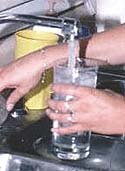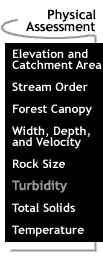
Water
Quality Assessment: Physical: Turbidity
 Turbidity is a
measure of water clarity. It tells scientists the degree to which light
entering a column of water is scattered by suspended
solids. Suspended solids include things such as mud, algae, detritus,
and fecal material. Factors contributing to water turbidity include soil
erosion, elevated nutrient inputs that stimulate algal blooms, waste discharge,
and an abundance of bottom feeders that stir up sediments. As water becomes
more turbid, less sunlight is able to penetrate its surface, therefore
the amount of photosynthesis that can
occur decreases. This results in a decrease in the amount of oxygen produced
by aquatic plants. In addition, suspended materials absorb heat from sunlight
and raise the water temperature. This also
limits the amount of dissolved oxygen water
can hold.
Turbidity is a
measure of water clarity. It tells scientists the degree to which light
entering a column of water is scattered by suspended
solids. Suspended solids include things such as mud, algae, detritus,
and fecal material. Factors contributing to water turbidity include soil
erosion, elevated nutrient inputs that stimulate algal blooms, waste discharge,
and an abundance of bottom feeders that stir up sediments. As water becomes
more turbid, less sunlight is able to penetrate its surface, therefore
the amount of photosynthesis that can
occur decreases. This results in a decrease in the amount of oxygen produced
by aquatic plants. In addition, suspended materials absorb heat from sunlight
and raise the water temperature. This also
limits the amount of dissolved oxygen water
can hold.
Turbidity can be measured in two ways. The first involves lowering a special black and white disk called a Secchi disk into the water and determining the maximum depth at which it is visible. The second method of measuring turbidity is a chemical method that involves titrating a turbidity solution into a sample until an equilibrium point is reached. The results of the Secchi disk method are reported in meters. The larger the value, the less turbid the water. The results of the chemical titration method are reported in Nephlometer Turbidity Units (NTU) or Jackson Turbidity Units (JTU), depending on the test kit. The smaller the value obtained from this method, the less turbid the water. Occasional short-term occurrences of high turbidity are common, for example after storm events or when an animal crosses a stream. To determine whether or not there is cause for concern over a high turbidity reading, the measurement should be repeated several times over a twenty-four hour period. In general, a turbidity value of > 40 NTU for at least twenty-four hours indicates a problem. Potential causes for high turbidity include dredging and acid mine drainage.
Overview ..|.. Biological Assessment ..|.. Chemical Assessment ..|.. Physical Assessment.
Elevation
and Catchment Area / Stream Order /
Forest Canopy / Width,
Depth, and Velocity / Rock Size / Turbidity
/ Total Solids / Temperature Home
..|..
Teacher Pages
..|..
Modules
& Activities
Glossary .|.
Related Links
.|..
References
..|..
PBL Model
.|
HTML code by Chris Kreger
Maintained by ETE Team
Last updated November 10, 2004
Some images © 2004 www.clipart.com
Privacy Statement and Copyright © 1997-2004 by Wheeling Jesuit University/NASA-supported Classroom of the Future. All rights reserved.
Center for Educational Technologies, Circuit Board/Apple graphic logo, and COTF Classroom of the Future logo are registered trademarks of Wheeling Jesuit University.
